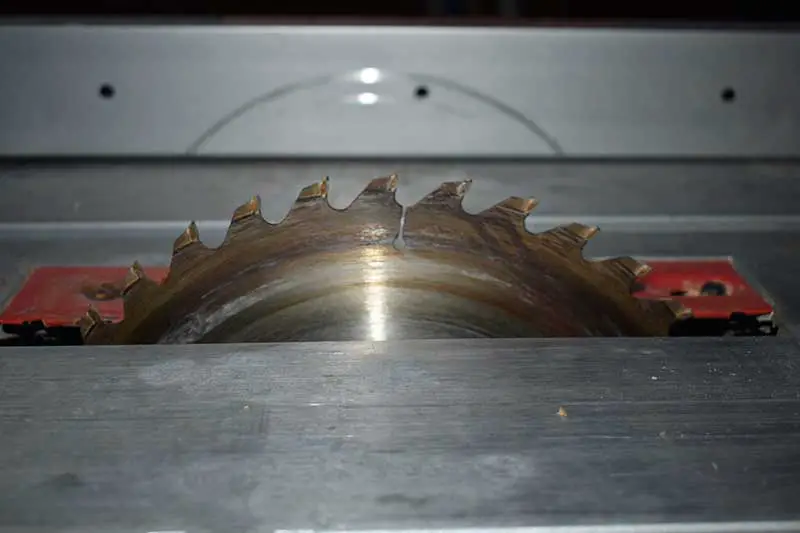To sharpen a table saw blade, remove it from the saw, clean it, inspect for damage, mark the starting tooth, sharpen the teeth using a diamond file or stone, balance the blade, and reinstall it.

Keeping your table saw blade sharp is essential for precise cuts and efficient operation. Dull blades can cause rough cuts, burn marks, and increased strain on the saw’s motor. This guide will walk you through the process of sharpening a table saw blade step by step.
Necessary Tools and Materials
Before you start sharpening your table saw blade, gather the following tools and materials:
- Blade balancer
- Blade cleaner
- Diamond file or diamond sharpening stone
- Flat work surface
- Safety glasses
- Soft-bristle brush
- Soft cloth
- Water (for wet sharpening stones)
Step 1: Remove the Blade from the Table Saw
Before you begin, ensure that the table saw is unplugged to prevent accidental startup. Remove the blade from the table saw by loosening and removing the arbor nut and washer. Carefully lift the blade off the arbor.
Step 2: Clean the Blade
Thoroughly clean the blade using a soft-bristle brush to remove sawdust, pitch, and other debris. For stubborn buildup, use a blade cleaner according to the manufacturer’s instructions. Cleaning the blade before sharpening ensures that the sharpening process is more effective and efficient.
Step 3: Inspect the Blade
Examine the blade for any damage, such as missing or chipped teeth. If the blade is severely damaged or worn, it may be more cost-effective to replace it rather than attempting to sharpen it.
Step 4: Mark the Starting Tooth
Use a permanent marker to mark the starting tooth on the blade to keep track of which teeth have been sharpened.
Step 5: Sharpen the Teeth
Put on safety glasses to protect your eyes from metal filings. Position the blade on a flat work surface with the teeth facing up. Hold the diamond file or diamond sharpening stone at the same angle as the bevel of the tooth.
Gently stroke the file or stone along the bevel of the tooth, following the existing angle. Use consistent pressure and make the same number of strokes for each tooth to ensure even sharpening. Move on to the next tooth, and continue sharpening until all the teeth have been sharpened.
Step 6: Balance the Blade
After sharpening, it’s essential to check and balance the blade to prevent vibrations and uneven cuts. Place the blade on a blade balancer and ensure that it sits level. If the blade is unbalanced, lightly sand the heavier side of the blade until it is balanced.
Step 7: Reinstall the Blade
Carefully reinstall the sharpened and balanced blade onto the table saw arbor. Replace the washer and arbor nut, and securely tighten the nut. Plug the table saw back in and test the saw to ensure smooth and accurate cutting.
| Step | Description |
|---|---|
| 1. | Remove the blade from the table saw |
| 2. | Clean the blade |
| 3. | Inspect the blade |
| 4. | Mark the starting tooth |
| 5. | Sharpen the teeth |
| 6. | Balance the blade |
| 7. | Reinstall the blade |
Table: Sharpening a Table Saw Blade
Additional Tips for Sharpening Table Saw Blades
Here are some extra tips to help you get the most out of sharpening your table saw blade:
Use the Right File or Sharpening Stone
It’s crucial to use a diamond file or diamond sharpening stone specifically designed for sharpening carbide-tipped saw blades. Using a standard file or sharpening stone can damage the carbide teeth and make the blade unusable.
Maintain Consistent Sharpening Angle
When sharpening the blade, try to maintain a consistent angle with the bevel of the tooth. This ensures that each tooth is sharpened evenly and maintains its original cutting geometry.
Practice on an Old Blade
If you’re new to sharpening table saw blades, practice on an old or inexpensive blade before attempting to sharpen your primary blade. This helps you develop your sharpening technique and avoid damaging a valuable blade.
Regularly Inspect and Maintain Your Blade
Regularly inspect your table saw blade for signs of wear, damage, or dullness. Keeping your blade clean and sharp will prolong its life and improve the quality of your cuts.
Consider Professional Sharpening Services
If you’re uncomfortable sharpening your table saw blade yourself or have a blade with a more complex tooth geometry, consider using a professional sharpening service. Professionals have the equipment and expertise to sharpen your blade accurately and efficiently.
Conclusion
Sharpening your table saw blade is a straightforward process that can significantly improve the performance and longevity of your blade. By following these steps and maintaining your blade, you can achieve precise cuts and keep your table saw running efficiently.
